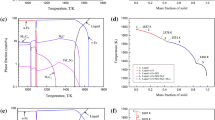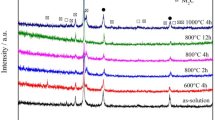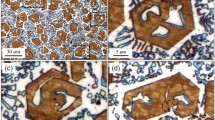Abstract
Combined with phase field simulation and experimental research, the growth and coarsening of M7C3 carbide precipitated from supersaturated austenite matrix were studied. Adopting the CALculation of PHAse Diagram (CALPHAD) method and thermodynamic database, the real Gibbs free energy of the austenite and M7C3 carbide phases in the Fe–Cr–C ternary alloy was established. The growth and coarsening of M7C3 carbide were simulated by phase field method. The microstructure and elements distribution of M7C3 carbide in Fe–Cr–C alloy were observed by field emission scanning electron microscope (FESEM) and energy-dispersive spectrometer (EDS) after various isothermal aging times (0 h, 0.5 h, 2 h) at 1273 K, respectively. Results show that the growth and coarsening of the precipitated M7C3 carbide phase undergo the following process during isothermal aging: first, a single precipitated phase nucleus is precipitated from the matrix; afterward, the single precipitated phase continues to coarsen and grow to form a plate-like structure, or two precipitated phases contact to form a single bar-like structure; then, several precipitated phase nucleuses contact to form an elongated bar shape, and finally, the elongated bar-shaped structure contacts and grows to form a typical lamellar eutectic carbide. In addition, through the analysis of the concentration field, the precipitated M7C3 carbide is a shell structure. The outer layer is a carbon-rich zone, and the inner part is a chromium-rich zone. By comparing the simulated morphology evolution with the experimental microstructure characterization and elements distribution via EDS, the correctness of the proposed phase field model has been verified.










Similar content being viewed by others
References
S. Pawar, G. Mukhopadhyay, Metallurgical and tribological evaluation of Fe–Cr–C hardfacing alloys. J. Fail. Anal. Prev. 18(4), 868–876 (2018)
S.-J. Lee, D.K. Matlock, C.J. Van Tyne, An empirical model for carbon diffusion in austenite incorporating alloying element effects. ISIJ Int. 51(11), 1903–1911 (2011)
A. Bedolla-Jacuinde, L. Béjar, SEM study on the M7C3 carbide nucleation during eutectic solidification of high-chromium white irons. Z. Metallkd. 96, 1380–1385 (2005)
A. Bjärbo, M. Hättestrand, Complex carbide growth, dissolution, and coarsening in a modified 12 pct chromium steel—an experimental and theoretical study. Metall. Mater. Trans. A. 32(1), 19–27 (2001)
S. Carpenter, D. Carpenter, X-ray diffraction study of M7C3 carbide within a high chromium white iron. Mater. Lett. (General ed) 57(28), 4456–4459 (2003)
C. Fan, M.-C. Chen, C.-M. Chang, W. Wu, Microstructure change caused by (Cr, Fe)23C6 carbides in high chromium Fe–Cr–C hardfacing alloys. Surf. Coat. Technol. 201(3), 908–912 (2006)
C.W. Kuo, C. Fan, S.H. Wu, W. Wu, Microstructure and wear characteristics of hypoeutectic, eutectic and hypereutectic (Cr, Fe)23C6 carbides in hardfacing alloys. Mater. Trans. 48(9), 2324–2328 (2007)
C.-M. Chang, Y.-C. Chen, W. Wu, Microstructural and abrasive characteristics of high carbon Fe–Cr–C hardfacing alloy. Tribol. Int. 43(5), 929–934 (2010)
Z.H. Wang, Q.B. Wang, L. Cui, A.D. Yang, D.Y. He, Influence of cooling rate and composition on orientation of primary carbides of Fe–Cr–C hardfacing alloys. Sci. Technol. Weld. Join. 13(7), 656–662 (2008)
J.J. Coronado, Effect of load and carbide orientation on abrasive wear resistance of white cast iron. Wear 270(11), 823–827 (2011)
M.R. Tonks, L.K. Aagesen, The phase field method: mesoscale simulation aiding material discovery. Annu. Rev. Mater. Res. 49(1), 79–102 (2019)
J.H. Panchal, S.R. Kalidindi, D.L. McDowell, Key computational modeling issues in integrated computational materials engineering. Comput. Aided Des. 45(1), 4–25 (2013)
Y. Li, Y. Gao, B. Xiao, T. Min, Y. Yang, S. Ma, D. Yi, The electronic, mechanical properties and theoretical hardness of chromium carbides by first-principles calculations. J. Alloy. Compd. 509(17), 5242–5249 (2011)
M.A. Konyaeva, N.I. Medvedeva, Electronic structure, magnetic properties, and stability of the binary and ternary carbides (Fe, Cr)3C and (Fe, Cr)7C3. Phys. Solid State 51(10), 2084–2089 (2009)
C. Jiang, First-principles study of structural, elastic, and electronic properties of chromium carbides. Appl. Phys. Lett. 92(4), 041909 (2008)
M. Militzer, Phase field modeling of microstructure evolution in steels. Curr. Opin. Solid State Mater. Sci. 15(3), 106–115 (2011)
Y. Tsukada, A. Shiraki, Y. Murata, S. Takaya, T. Koyama, M. Morinaga, Phase-field simulation of nucleation and growth of M23C6 carbide and ferromagnetic phases during creep deformation in Type 304 steel. J. Nucl. Mater. 401(1), 154–158 (2010)
J.W. Cahn, J.E. Hilliard, Free energy of a nonuniform system. I. Interfacial free energy. J. Chem. Phys. 28(2), 258–267 (1958)
T. Koyama, K. Hashimoto, H. Onodera, Phase-field simulation of phase transformation in Fe–Cu–Mn–Ni quaternary alloy. Mater. Trans. 47(11), 2765–2772 (2006)
H.K. Yeddu, A. Borgenstam, J. Ågren, Stress-assisted martensitic transformations in steels: a 3-D phase-field study. Acta Mater. 61(7), 2595–2606 (2013)
A.A. Wheeler, W.J. Boettinger, G.B. McFadden, Phase-field model for isothermal phase transitions in binary alloys. Phys. Rev. A 45(10), 7424–7439 (1992)
J.Z. Zhu, T. Wang, A.J. Ardell, S.H. Zhou, Z.K. Liu, L.Q. Chen, Three-dimensional phase-field simulations of coarsening kinetics of γ′ particles in binary Ni–Al alloys. Acta Mater. 52(9), 2837–2845 (2004)
T. Wang, An Integrated Approach for Microstructure Simulation: Application to Ni–Al–Mo Alloys (The Pennsylvania State University, Pennsylvania, 2006)
L.Q. Chen, J. Shen, Applications of semi-implicit Fourier-spectral method to phase field equations. Comput. Phys. Commun. 108(2), 147–158 (1998)
J. Bratberg, J. Ågren, K. Frisk, Diffusion simulations of MC and M7C3 carbide coarsening in bcc and fcc matrix utilising new thermodynamic and kinetic description. Mater. Sci. Technol. 24(6), 695–704 (2008)
C. Zheng, D. Raabe, Interaction between recrystallization and phase transformation during intercritical annealing in a cold-rolled dual-phase steel: a cellular automaton model. Acta Mater. 61(14), 5504–5517 (2013)
A. Bedolla-Jacuinde, L. Arias, B. Hernández, Kinetics of secondary carbides precipitation in a high-chromium white iron. J. Mater. Eng. Perform. 12(4), 371–382 (2003)
M. Qian, In-situ observations of the dissolution of carbides in an Fe–Cr–C alloy. Scr. Mater. 41(12), 1301–1303 (1999)
M. Filipovic, E. Romhanji, Z. Kamberovic, Chemical composition and morphology of M7C3 eutectic carbide in high chromium white cast iron alloyed with vanadium. ISIJ Int. 52(12), 2200–2204 (2012)
E.S. Vasyukova, K.Y. Okishev, A.S. Sozykina, A.M. Karlikov, D.A. Mirzaev, Kinetic description of (Cr, Fe)7C3 carbide precipitation from austenite in high-carbon Fe–Cr–C ternary alloys. Solid State Phenom. 265, 1005–1010 (2017)
K. Zelič, J. Burja, P.J. McGuiness, M. Godec, Effect of rare earth elements on the morphology of eutectic carbides in AISI D2 tool steels: experimental and modelling approaches. Sci. Rep. 8(1), 9233 (2018)
U.P. Nayak, M.A. Guitar, F. Mücklich, A comparative study on the influence of chromium on the phase fraction and Elemental distribution in as-cast high chromium cast irons: simulation vs experimentation. Metals 10(1), 30 (2020)
K. Wieczerzak, P. Bala, R. Dziurka, T. Tokarski, G. Cios, T. Koziel, L. Gondek, The effect of temperature on the evolution of eutectic carbides and M7C3 → M23C6 carbides reaction in the rapidly solidified Fe–Cr–C alloy. J. Alloys Compd. 698, 673–684 (2017)
A.V. Khvan, B. Hallstedt, C. Broeckmann, A thermodynamic evaluation of the Fe–Cr–C system. Calphad 46, 24–33 (2014)
J.-O. Andersson, A thermodynamic evaluation of the Fe–Cr–C system. Metall. Trans. A 19(3), 627–636 (1988)
J.-O. Andersson, Thermodynamic properties of Cr–C. Calphad 11(3), 271–276 (1987)
Acknowledgements
This work was supported by the National Natural Science Foundation of China [Grant Nos. 51974153, U1960203].
Author information
Authors and Affiliations
Contributions
LL contributed to the conceptualization, methodology, formal analysis, investigation, data curation, and writing—original draft. MC was software, validation, and writing—review and editing. WL contributed to the resources, funding acquisition, and writing–review and editing. XZ and ZJ contributed to the resources and funding acquisition. BW and JJ were involved in the data curation.
Corresponding author
Ethics declarations
Conflict of interest
The authors declare that they have no known competing financial interests or personal relationships that could have appeared to influence the work reported in this paper.
Data availability
The raw/processed data required to reproduce these findings cannot be shared at this time as the data also form part of an ongoing study.
Additional information
Publisher's Note
Springer Nature remains neutral with regard to jurisdictional claims in published maps and institutional affiliations.
Appendix
Appendix
The molar Gibbs energy for the FCC phase was described using a two-sublattice model \({\text{(Fe,Cr)(C,Va)}}\) (Table
3).
where
where the site fraction of component \(i\) is marked as \(y_{i}\) and the relationship between site fraction and mole fraction can be expressed as:
All the \({}^{0}G\) values are given relative to the enthalpy of selected reference states for the elements at 298.15 K. The comma separates components that interact in the same sublattice and colon is used to separate between different sublattices. \(R\) and \(T\) are gas constant and temperature. The \(L_{i,j}^{\phi }\)(binary interaction parameters) can be concentration dependent according to a Redlich–Kister polynomial,
where
The M7C3 carbide was treated with the two-sublattice model \({\text{(Fe,Cr)}}_{{7}} {\text{C}}_{{3}}\) and its molar free energy was described as
where \({}^{0}G_{i:{\text{C}}}^{{{\text{M}}_{7} {\text{C}}_{3} }}\) is the Gibbs energy of a pure binary carbide, the binary interaction parameter \(L_{{\text{Cr,Fe:C}}}^{{{\text{M}}_{{7}} {\text{C}}_{{3}} }}\) in Eq. A.7 is
Rights and permissions
About this article
Cite this article
Li, L., Chen, M., Li, W. et al. Growth and coarsening of eutectic M7C3 carbide in Fe–Cr–C alloy during isothermal aging: phase field simulation and experimental research. Appl. Phys. A 127, 888 (2021). https://doi.org/10.1007/s00339-021-05031-5
Received:
Accepted:
Published:
DOI: https://doi.org/10.1007/s00339-021-05031-5




